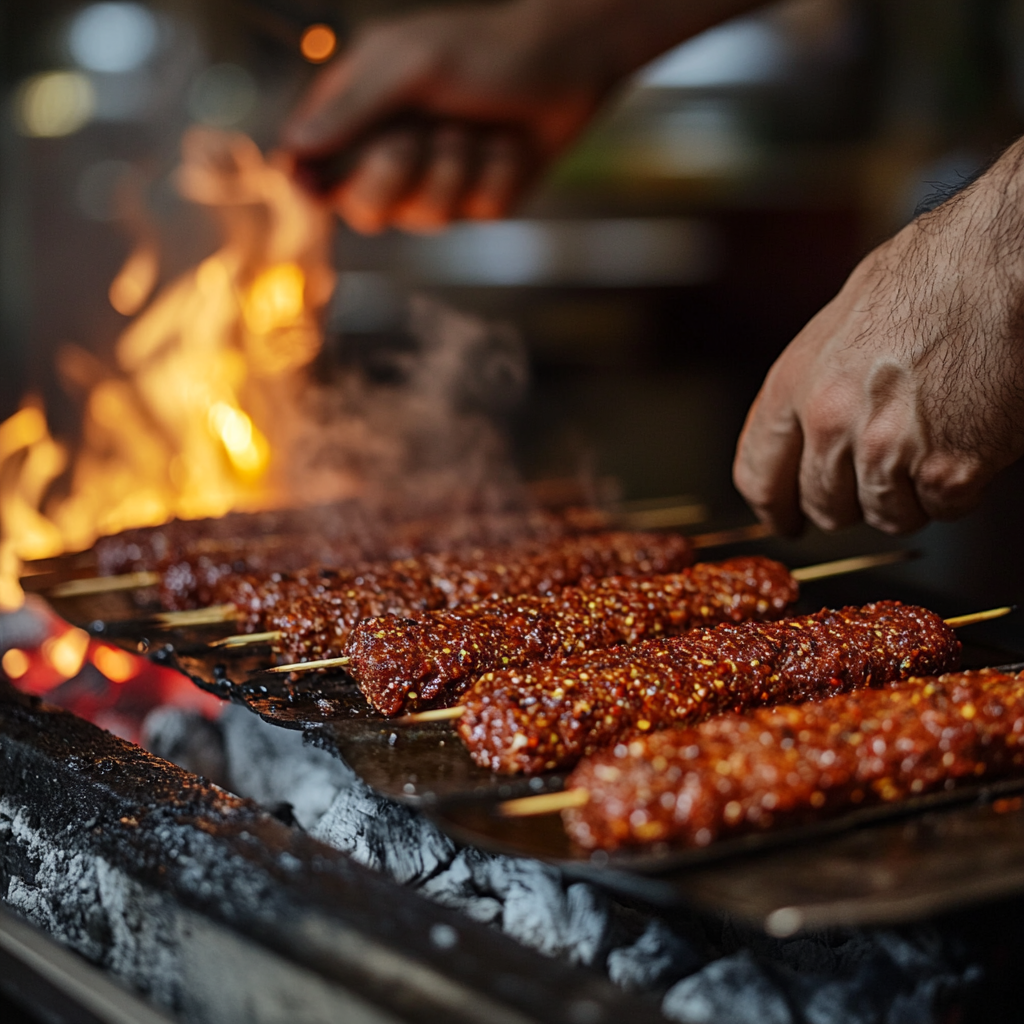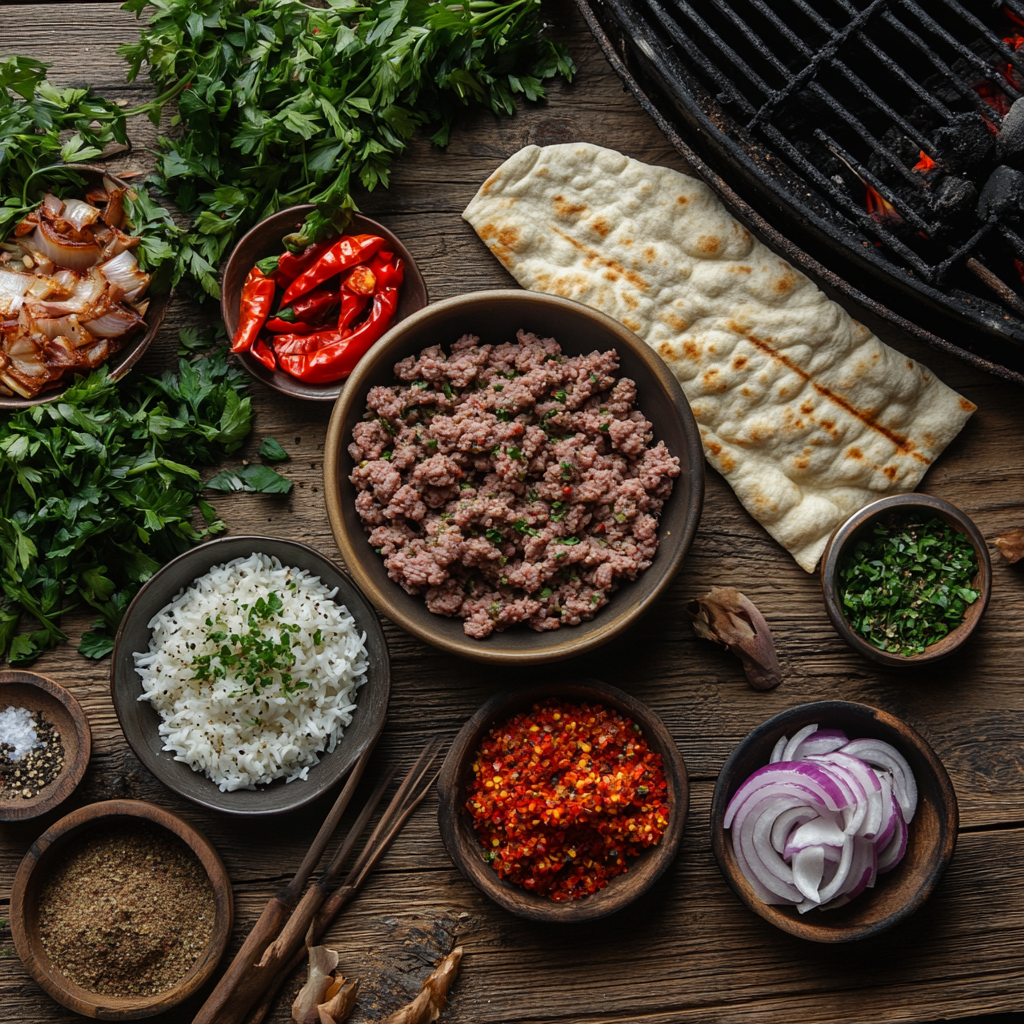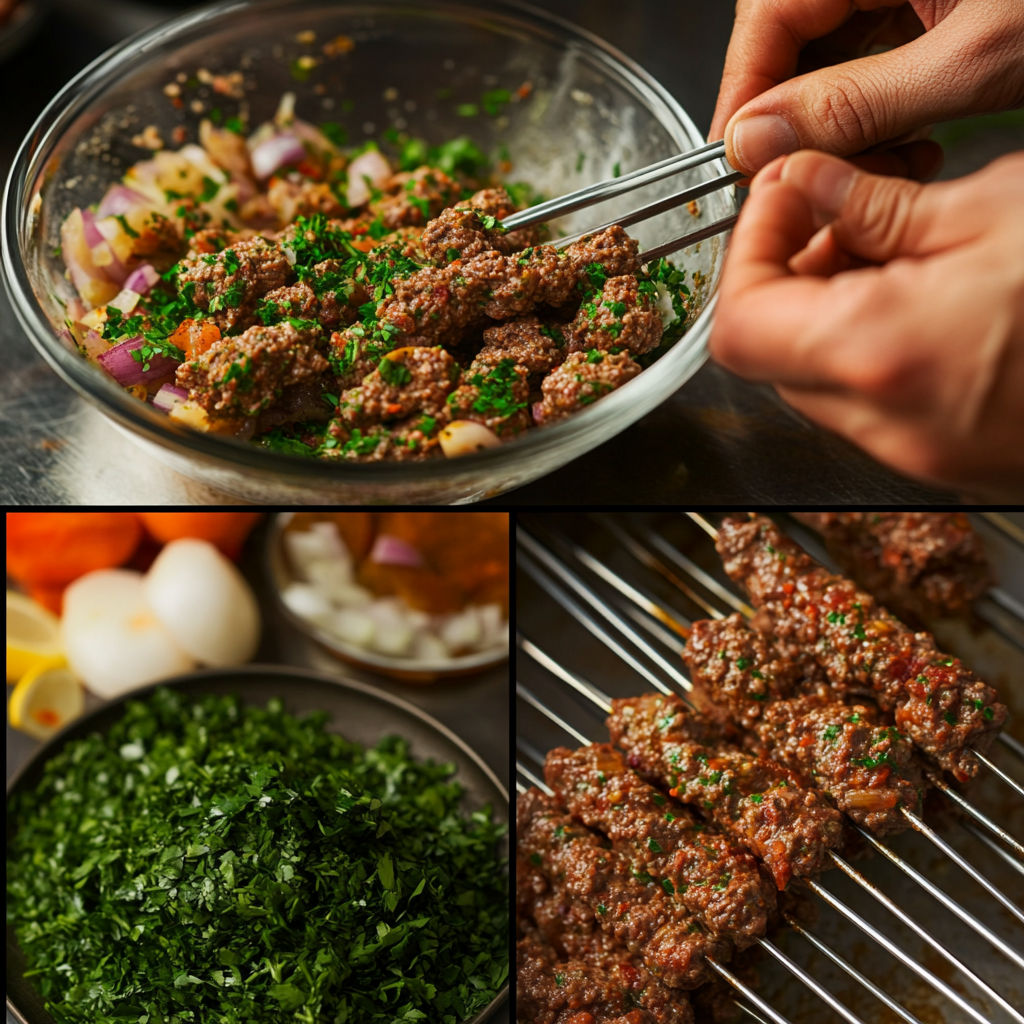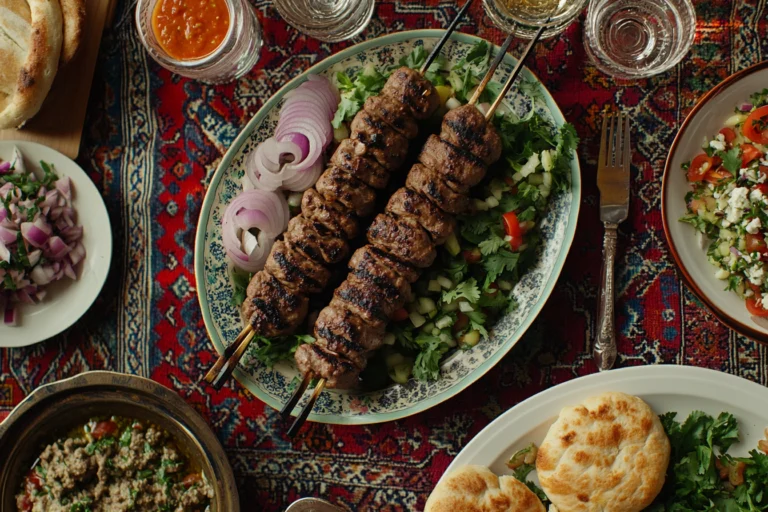What Is the Difference Between Kebab and Adana?
Kebabs are a beloved staple in cuisines around the world, each variety brimming with unique flavors and cultural significance. Among them, Adana kebab stands out as a spicy and distinct offering from Turkey. But what exactly sets it apart from other types of kebabs? In this guide, we’ll delve into the origins, preparation, cooking techniques, flavors, and cultural importance of both kebabs and Adana kebab. Let’s explore these mouthwatering dishes, their similarities, and their key differences to enrich your culinary knowledge.
Understanding Kebab and Adana
Definition of Kebab
Kebabs, a hallmark of global cuisine, feature grilled or roasted meats that delight food lovers worldwide. Cooks typically prepare them by skewering meat and cooking it over an open flame, though variations exist. Lamb is the most traditional meat used in kebabs, but chicken, beef, and even seafood frequently make appearances in different regional recipes.
The flavor profile of kebabs depends on the spices, marinades, and herbs used during preparation. Each region brings its own touch, creating unique variations that highlight local ingredients and culinary traditions. Their diversity and adaptability have helped kebabs secure a place on dinner tables across the globe.
Introduction to Adana Kebab
Among the countless types of kebabs, Adana kebab stands out for its bold flavors and cultural significance. This variety originates from Adana, a vibrant city in southern Turkey, where locals consider it a culinary treasure. Chefs create it using minced lamb mixed with spices like red pepper flakes and parsley, then shape the mixture onto flat metal skewers.
What sets Adana kebab apart is its fiery taste and the distinctive aroma it gains during charcoal grilling. This dish reflects Adana’s rich culinary heritage and continues to captivate food enthusiasts, offering a spicy twist that distinguishes it from other kebab types.
Historical Background
Origins of Kebab
Early History and Cultural Significance
The origins of kebabs date back thousands of years to the heart of the Middle East and Central Asia. Historians widely believe that nomadic tribes, who relied on fire-cooked meals, invented the concept of skewering meats for roasting. The Arabic word “kabāb,” meaning roasted or grilled, gave kebabs their name, and they soon became a staple in Middle Eastern cuisine.
Kebabs historically represented more than just food—they reflected cultural traditions. Grand feasts often showcased kebabs as symbols of hospitality and wealth. Royals and emperors indulged in meticulously prepared versions, highlighting their significance. Generations passed down the art of kebab-making, embedding it deeply into the region’s culinary practices.
Regional Variations Across the Middle East
Kebabs evolved as they traveled across borders. In Persia, you’d find chelo kebab served with fragrant rice, while Turkey developed its famous şiş kebab cooked on skewers. Meanwhile, South Asia introduced rich, spiced varieties like seekh kebab. Each region added its own touch—different spices, marinades, and even cooking methods—turning kebabs into a versatile global phenomenon.
The Birthplace of Adana Kebab
Historical Context in Adana, Turkey
The Adana kebab takes its name from the vibrant city of Adana, situated in southern Turkey. This dish emerged during the Ottoman Empire and has since gained global acclaim. Adana’s fertile lands, rich with spices and herbs, provided the perfect ingredients for crafting a dish that captures the fiery spirit of the region.
The kebab reflects the culinary identity of Adana’s inhabitants, blending cultural influences from Turkish, Arabic, and Kurdish communities. Its distinctive spiciness and preparation methods set it apart, making it a defining feature of the city’s gastronomy.
Evolution Over Time
Over the centuries, Adana kebab has maintained its authenticity while evolving to suit modern tastes. Traditional techniques—like mixing minced lamb with fat and spices, skewering it on flat metal skewers, and grilling over hot charcoal—remain central to its preparation. Yet, chefs have introduced variations, such as milder versions or pairings with diverse accompaniments, to appeal to broader audiences.
Ingredients and Preparation
Common Ingredients in Kebabs
Meat Varieties Used
Kebabs feature a wide range of meats, with lamb being the most traditional and popular choice, especially in Middle Eastern and Turkish cuisine. In addition to lamb, people commonly use beef and chicken, adapting to local dietary preferences and availability. In coastal areas, seafood options like fish and prawns also make an appearance.
Vegetarian versions, crafted with paneer, spiced vegetables, or legumes, cater to non-meat eaters, highlighting the dish’s incredible versatility.
Typical Spices and Marinades
The marinade plays a crucial role in creating flavorful kebabs. Chefs often use aromatic spices like cumin, coriander, paprika, and turmeric, paired with fresh herbs such as parsley or cilantro. To tenderize the meat and enhance its flavor, they include yogurt, lemon juice, or vinegar.
Each region customizes its spice blend. For example, Persian kebabs may feature saffron for a luxurious touch, while Turkish kebabs often incorporate sumac for a citrusy kick. Marinating the meat for several hours—or even overnight—ensures the flavors penetrate deeply, resulting in a tender and well-seasoned dish.
Specifics of Adana Kebab Preparation
Meat Selection and Quality
To create Adana kebab, chefs choose high-quality lamb and mix it with just the right amount of fat to ensure juiciness. Traditionally, cooks mince the meat by hand to achieve the ideal consistency, which feels textured yet smooth. This careful preparation ensures the kebab holds its shape during cooking.
Unique Spice Blend and Seasoning
The bold, fiery flavor of Adana kebab comes from its unique spice blend. Chefs mix red pepper flakes, cumin, and black pepper with fresh parsley to create a balance of heat and herbaceous notes. Generous seasoning with salt enhances the flavors further, ensuring a mouthwatering result.
Skewering and Grilling Techniques
After preparing the meat, cooks shape it by hand onto flat metal skewers. This traditional technique not only forms the kebab’s characteristic shape but also ensures even cooking. They grill the skewered meat over hot charcoal, which imparts a smoky aroma that defines Adana kebab.
Chefs control the heat meticulously, adjusting the skewers’ proximity to the coals to prevent burning or undercooking. They also rotate the kebabs frequently, ensuring every side cooks evenly. This attention to detail results in a perfectly charred exterior and a tender, juicy interior.
Cooking Techniques
Various Methods of Cooking Kebabs
Grilling, Baking, and Frying
Kebabs can be cooked in many ways. Grilling is the most common method, giving the meat its smoky flavor. Whether on an open flame or a gas grill, grilling enhances the spices and creates a tasty char on the surface.
For those without a grill, baking is a great alternative. Cooking kebabs in the oven keeps them juicy and flavorful, even though it doesn’t provide the same smoky taste.
Frying is another option, often used for smaller kebabs like seekh kebabs. Pan-frying or deep-frying creates a crispy outside that contrasts with the soft and tender inside.
Use of Skewers and Open Flames
Skewers are a key part of many kebabs. Metal skewers cook the meat evenly, while wooden ones are handy and easy to use. They also help keep the meat off the grill, avoiding sticking or overcooking.
Cooking over an open flame is considered the best way to make kebabs. The direct heat adds a smoky taste that matches perfectly with the spices and fat in the meat. This method has stayed popular for centuries because of the unmatched flavor it brings.
Traditional Cooking Method for Adana Kebab
Charcoal Grilling Process
The unique taste of Adana kebab comes from grilling it over hot charcoal. The glowing coals provide steady heat, giving the kebabs a smoky aroma and charred flavor. This balance makes the outside slightly crisp while keeping the inside juicy.
Chefs often choose hardwood charcoal because it burns longer and creates clean smoke, which doesn’t overpower the flavors. The flat metal skewers used for Adana kebab also help distribute heat evenly, ensuring each kebab cooks just right.

Importance of Heat Control
Cooking Adana kebab is more than just grilling meat—it’s about managing the heat. Cooks adjust the skewers’ height to avoid burning or undercooking the meat. High heat can char the outside too quickly, while low heat may leave the inside raw.
Rotating the skewers frequently helps the kebabs cook evenly. Skilled cooks know when to pull the kebabs off the grill, ensuring they’re perfectly cooked with a smoky and flavorful finish.
Flavor Profiles
Taste and Texture of General Kebabs
Influence of Marinades and Cooking Methods
I see that you’ve uploaded an image with highlighted complex words. I’ll transcribe and simplify the highlighted words for you. Give me a moment to process this.
Here’s a simplified version of the text where the complex highlighted words have been replaced with simpler alternatives:
The taste and texture of kebabs are greatly shaped by their marinades and cooking methods. A well-seasoned kebab boasts layers of flavor—spices, herbs, and acidic elements like lemon juice or yogurt work together to enhance the natural taste of the meat while softening it. The time of marination also plays an important role; overnight marination ensures a deeper blend of flavors.
Cooking methods make these flavors stronger. Grilling adds a smoky, charred layer that goes well with the spices, while baking keeps the meat’s moisture. Fried kebabs, on the other hand, develop a crispy crust, offering a pleasant contrast to the tender interior. The different texture varies: grilled kebabs are often firm with a crispy outside, whereas baked or fried versions can be softer and slightly juicier..
Distinctive Flavor of Adana Kebab
Spiciness Level and Aromatic Qualities
The Adana kebab is closely linked with bold and fiery flavors. It owes its unique spiciness to the generous use of red pepper flakes, which give it a heat that lingers but doesn’t overpower. This spice is evened out by earthy cumin and flavorful black pepper, creating a balance of flavors that excite the palate.
Fresh parsley, often mixed into the meat, adds a bright, fresh note that cuts through the richness of the lamb. Combined with the smoky aroma from grilling, these elements create a memorable taste that’s uniquely Adana. The texture is equally remarkable—tender and juicy on the inside, with a lightly crisp, charred outside.
Comparison with Other Regional Kebabs
While Adana kebab stands out for its spicy taste, other regional kebabs offer different flavor profiles. For instance, Urfa kebab—another Turkish favorite—is similar in preparation but much milder, suiting those who prefer less heat. Persian kebabs, such as kabab koobideh, are flavored with saffron and turmeric, offering a subtler and more fragrant taste.
Indian kebabs like seekh kebab are heavily spiced with garam masala, garlic, and ginger, creating a robust and intense flavor. In contrast, shish kebabs focus more on the natural flavor of the meat, with lighter seasoning and a focus on grilling techniques.
Serving Styles and Accompaniments
Traditional Sides Served with Kebabs
Breads, Salads, and Sauces
Kebabs shine best when paired with matching sides that enhance their flavors. Flatbreads, such as naan, lavash, or pita, are a classic choice, often used to wrap the meat or soak up tasty juices. These breads serve as a neutral base, letting the kebab’s spices take center stage.
Fresh salads like chopped cucumber and tomato, dressed with lemon juice and olive oil, bring a crisp and refreshing mix. Tabouli, a parsley-filled Mediterranean salad, is another popular pairing. For added zest, pickled vegetables are often served alongside.
No kebab meal is complete without tasty sauces. Yogurt-based sauces like tzatziki or garlic dip add smoothness, while chili sauces provide an extra kick. Hummus, made from blended chickpeas, is a hearty side dish that goes well with the smoky flavor of kebabs perfectly.
Typical Presentation of Adana Kebab
Accompaniments Like Şalgam and Onion Salad
The presentation of Adana kebab is a feast for the senses. Traditionally, it’s served on a bed of warm lavash bread or alongside rice pilaf. The bread often absorbs the kebab’s juices, making every bite a flavorful delight.
Common accompaniments include şalgam, a tangy and slightly spicy fermented turnip juice that balances the kebab’s richness. A staple side is onion salad, thinly sliced onions mixed with sumac, parsley, and a dash of lemon juice, which cuts through the spiciness of the kebab and refreshes the palate.
Grilled vegetables like tomatoes, peppers, and eggplant often flank the kebab, adding smoky, charred sweetness. These vibrant accompaniments elevate the dish to a complete meal, perfect for savoring alone or sharing with loved ones.
Nutritional Information
Nutritional Profile of Various Kebabs
Calorie Count and Macronutrient Breakdown
The nutritional value of kebabs varies depending on the ingredients and cooking methods. On average, a standard kebab made with lean meat provides around 200–250 calories per serving. Most of these calories come from protein, making kebabs a high-protein option for meals.
Lamb and beef kebabs tend to have higher fat content, which contributes to their rich flavor, while chicken kebabs are leaner and lower in calories. When grilled, the fat content is reduced compared to fried versions, as excess fat drips off during cooking.
Carbohydrates are minimal unless served with bread or rice, which can significantly increase the calorie count. Adding salads and vegetables keeps the meal nutrient-dense and fiber-rich, promoting better digestion.
Health Aspects of Adana Kebab
Fat Content and Spiciness Considerations
Adana kebab is indulgent yet balanced. Its fat content, primarily from lamb, contributes to its juicy texture but can be high. Opting for moderate portions or pairing it with fresh vegetables and lighter sides can create a healthier meal.
The kebab’s spiciness, thanks to red pepper flakes, has its benefits too. Capsaicin, the compound that gives chili peppers their heat, may boost metabolism and improve circulation. However, for those sensitive to spice, it’s worth noting that the heat can occasionally cause discomfort.
By maintaining a balance between indulgence and moderation, Adana kebab can be an enjoyable and nutritious part of a well-rounded diet. Next, we’ll explore the cultural significance of kebabs and their role in festive traditions!
Cultural Significance
Role of Kebabs in Middle Eastern Cuisine
Social and Festive Occasions
Kebabs have a deep-rooted significance in Middle Eastern culture, transcending their role as a mere dish. They are often the centerpiece of social gatherings, symbolizing hospitality and celebration. From family dinners to grand feasts, kebabs foster a sense of togetherness, with their smoky aroma filling the air as they are grilled over open flames.
Festive occasions like weddings, religious holidays, and community events frequently feature kebabs. They are considered a treat, especially when prepared with premium meats and spices. Traditionally, men gather around the grill, passing down the art of kebab-making, while the women prepare sides and breads. This collaborative process highlights the cultural importance of sharing food as a bonding experience.
Across regions, kebabs are not just enjoyed for their flavor but also as a way to honor heritage, with each recipe telling a story of tradition and history.
Importance of Adana Kebab in Turkish Culture
Festivals and Traditions in Adana
In Turkey, Adana kebab holds a special place in the country’s culinary and cultural tapestry. In the city of Adana, this dish is celebrated as a symbol of regional pride. The Adana Kebab Festival, held annually, draws food lovers from around the world to enjoy authentic kebabs prepared by master chefs.
This kebab is also a key part of Turkish family traditions, especially during gatherings where meals are prepared communally. The preparation process—meticulously seasoning the meat, skewering it, and grilling it to perfection—often becomes a social activity, reflecting the Turkish value of sofra (the shared table).
Beyond its flavor, Adana kebab represents the city’s resilience and creativity, uniting locals and visitors in a shared appreciation for culinary artistry.
Variations and Similar Dishes
Different Types of Kebabs Worldwide
Shish Kebab, Doner Kebab, and More
Kebabs have traveled across continents, adapting to diverse cultures and culinary preferences. In Turkey, shish kebab is a popular variant featuring chunks of marinated meat grilled on skewers. Doner kebab, made with thinly sliced meat roasted on a vertical spit, has gained global fame as a versatile fast food option.
In the Middle East, chefs combine minced meat with herbs and spices to create kofta kebabs, shaping them into cylindrical patties before grilling. Indian kebabs, such as seekh kebab, feature generous seasoning with garam masala and are often paired with chutneys. Persian kabab koobideh highlights saffron and onions as key flavors, served alongside fragrant rice for a complete meal.
Comparison Between Adana and Urfa Kebab
Differences in Spice Levels and Preparation
Adana kebab and Urfa kebab share similarities, but their flavor profiles differ significantly. Red pepper flakes give Adana kebab its signature fiery heat, while Urfa kebab uses subtle spices to highlight the meat’s natural flavor, resulting in a milder taste.
The preparation also varies slightly. While both use minced lamb, Adana kebab often includes a higher fat content to balance its spice level, resulting in a juicier texture. Urfa kebab typically incorporates fewer spices, focusing on achieving a smooth, tender consistency.
These differences make them unique, appealing to a wide range of palates and showcasing the versatility of Turkish kebabs.
How to Make Adana Kebab at Home
Step-by-Step Recipe Guide
Ingredients Needed
To create authentic Adana kebab at home, you’ll need a few fresh and flavorful ingredients:
- Meat: 500g of lamb, finely minced (include about 20% fat for juiciness).
- Spices: 2 tsp red pepper flakes, 1 tsp cumin, 1 tsp black pepper, and salt to taste.
- Aromatics: 1 small onion (grated) and a handful of chopped parsley.
- Others: Flat metal skewers, charcoal grill or grill pan, and lavash bread or rice for serving.

Preparation Instructions
- Prepare the Meat: In a mixing bowl, combine the minced lamb with grated onion, chopped parsley, and spices. Mix thoroughly to distribute the flavors evenly. Knead the mixture for several minutes until it becomes sticky and holds together.
- Shape the Kebabs: Wet your hands to prevent sticking, and mold the meat mixture onto flat metal skewers, creating elongated shapes about 1 inch thick. Ensure the kebab clings firmly to the skewer.
- Chill: Place the skewered meat in the refrigerator for 30 minutes to firm up, making it easier to handle while cooking.

Cooking Tips for Authentic Flavor
- Use Charcoal: If possible, grill over hot charcoal to infuse a smoky aroma that’s central to Adana kebab’s signature flavor.
- Control the Heat: Ensure the coals are glowing but not flaming. Rotate the skewers frequently to achieve even cooking.
- Avoid Overcooking: Grill each kebab for 8-10 minutes, turning occasionally, until the exterior is charred and the interior is juicy.
- Serve Fresh: Serve immediately with lavash bread, onion salad, and grilled vegetables for a complete experience.
Dining Experiences
Where to Find Authentic Kebabs Globally
Renowned Restaurants and Street Food Vendors
Kebabs have become a global culinary icon, and you can now find authentic versions in countless destinations. For instance, in Turkey, cities like Istanbul and Gaziantep are famous for their kebab culture, with restaurants like Çiya Sofrası offering a rich array of regional kebabs.
Similarly, in the Middle East, Beirut’s bustling streets are lined with vendors serving freshly grilled shish kebabs. On the other hand, Dubai’s fine-dining establishments often feature a luxurious twist, showcasing perfectly spiced Persian-style kebabs.
Meanwhile, across Europe, you’ll discover renowned spots like Mangal Ocakbaşı in London, which is celebrated for its traditional Turkish grills. Moreover, in the United States, cities like New York and Los Angeles boast vibrant Middle Eastern communities, where restaurants specialize in authentic kebab dishes.
Experiencing Adana Kebab in Turkey
Adana itself is the ultimate destination for experiencing the authentic taste of its namesake kebab. The city’s culinary scene is steeped in tradition, with local eateries showcasing the finest versions of this iconic dish.
Notable Eateries in Adana
- Kaburgacı Yaşar Usta: Known for its expertly prepared kebabs and warm hospitality.
- Adana Ocakbaşı: A favorite spot among locals for its smoky, flavorful Adana kebab.
- Birbiçer Kebap Salonu: Renowned for its adherence to traditional recipes and exceptional quality.
Frequently Asked Questions
What distinguishes Adana Kebab from other kebabs?
Adana kebab stands out because of its bold spiciness and unique preparation. Chefs mix minced lamb with red pepper flakes and other spices, then hand-shape it onto flat metal skewers before grilling it over charcoal. This technique creates its distinct smoky aroma and rich flavor, making it different from milder kebabs like shish kebab or Urfa kebab.
Is Adana Kebab always spicy?
Yes, the spiciness defines Adana kebab. Red pepper flakes ensure it has a fiery kick. However, some restaurants offer milder versions for individuals who prefer less heat.
Can Adana Kebab be made with meats other than lamb?
Traditionally, chefs prepare Adana kebab with lamb, but they sometimes use beef or a combination of lamb and beef. Although chicken is less traditional, it serves as an option for people looking for alternative flavors.
What does Chicken Adana taste like?
Chicken Adana, or Tavuk Adana, delivers a rich and satisfying taste profile. The chicken is flavored with spices like paprika, chili flakes, cumin, and garlic, which provide a mild kick of heat and a smoky undertone. Fresh parsley adds a vibrant, herbaceous touch, while charcoal grilling infuses a signature smokiness. The result is a dish that balances tender, juicy chicken with savory, spicy, and herbal notes, creating a harmonious and delicious experience.
What kind of meat is Adana?
Authentic Adana kebab is prepared with finely minced lamb or a mix of lamb and beef. The recipe traditionally incorporates lamb tail fat, which enhances the flavor and keeps the meat moist during grilling. The key to a genuine Adana kebab lies in the quality of the meat and the skillful blend of spices, which together create its distinctive texture and bold flavor.
What is Tavuk Adana?
Tavuk Adana, also known as Chicken Adana, is a variation of the traditional Adana kebab that substitutes minced chicken for lamb or beef. The chicken is seasoned with a blend of spices and herbs, molded onto flat skewers, and grilled over charcoal. This preparation results in a lighter version of the classic dish while retaining the same smoky aroma and robust flavor. Often paired with flatbread, grilled vegetables, and a fresh salad, Tavuk Adana offers a wholesome and flavorful meal that appeals to a variety of palates.
Summarizing the Differences Between Kebab and Adana Kebab
Key Takeaways on Preparation, Flavor, and Cultural Significance
Kebabs, in their many forms, are a testament to the diversity of global cuisine. Adana kebab, however, stands out as a fiery and flavorful delicacy with deep roots in Turkish culture. Its distinct preparation—using minced lamb, red pepper flakes, and charcoal grilling—creates a bold taste that sets it apart from other kebab varieties.
While general kebabs offer versatility with different meats, marinades, and cooking methods, Adana kebab carries the essence of its namesake city, reflecting its vibrant culinary heritage. Whether enjoyed at a family gathering or during a festival in Adana, this dish epitomizes the harmony of flavor, tradition, and artistry.
Dive into the world of kebabs, and don’t miss the opportunity to savor the unforgettable taste of Adana kebab!

